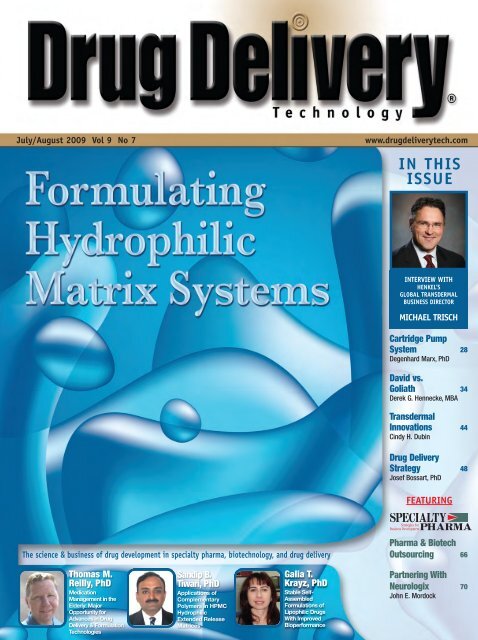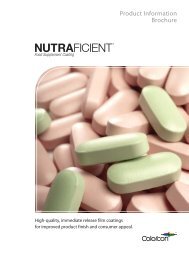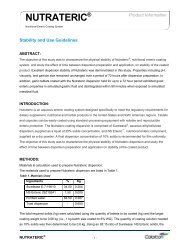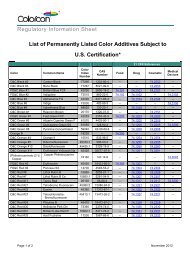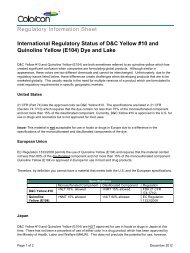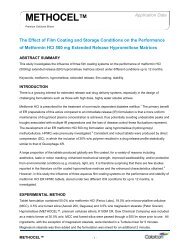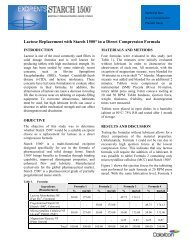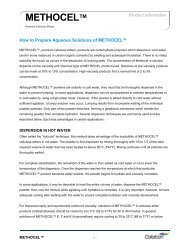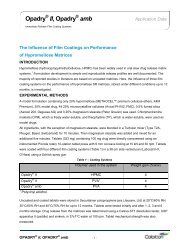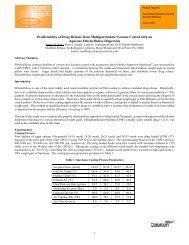Applications of Complementary Polymers in HPMC ... - Colorcon
Applications of Complementary Polymers in HPMC ... - Colorcon
Applications of Complementary Polymers in HPMC ... - Colorcon
You also want an ePaper? Increase the reach of your titles
YUMPU automatically turns print PDFs into web optimized ePapers that Google loves.
July/August 2009 Vol 9 No 7<br />
www.drugdeliverytech.com<br />
IN THIS<br />
ISSUE<br />
INTERVIEW WITH<br />
HENKEL’S<br />
GLOBAL TRANSDERMAL<br />
BUSINESS DIRECTOR<br />
MICHAEL TRISCH<br />
Cartridge Pump<br />
System 28<br />
Degenhard Marx, PhD<br />
David vs.<br />
Goliath 34<br />
Derek G. Hennecke, MBA<br />
Transdermal<br />
Innovations 44<br />
C<strong>in</strong>dy H. Dub<strong>in</strong><br />
Drug Delivery<br />
Strategy 48<br />
Josef Bossart, PhD<br />
FEATURING<br />
The science & bus<strong>in</strong>ess <strong>of</strong> drug development <strong>in</strong> specialty pharma, biotechnology, and drug delivery<br />
Pharma & Biotech<br />
Outsourc<strong>in</strong>g 66<br />
Thomas M.<br />
Reilly, PhD<br />
Medication<br />
Management <strong>in</strong> the<br />
Elderly: Major<br />
Opportunity for<br />
Advances <strong>in</strong> Drug<br />
Delivery & Formulation<br />
Technologies<br />
Sandip B.<br />
Tiwari, PhD<br />
<strong>Applications</strong> <strong>of</strong><br />
<strong>Complementary</strong><br />
<strong>Polymers</strong> <strong>in</strong> <strong>HPMC</strong><br />
Hydrophilic<br />
Extended Release<br />
Matrices<br />
Galia T.<br />
Krayz, PhD<br />
Stable Self-<br />
Assembled<br />
Formulations <strong>of</strong><br />
Lipophilic Drugs<br />
With Improved<br />
Bioperformance<br />
Partner<strong>in</strong>g With<br />
Neurologix 70<br />
John E. Mordock
<strong>Applications</strong> <strong>of</strong> <strong>Complementary</strong> <strong>Polymers</strong> <strong>in</strong> <strong>HPMC</strong><br />
Hydrophilic Extended Release Matrices<br />
By: Sandip B. Tiwari, PhD, and Ali R. Rajabi-Siahboomi, PhD<br />
ABSTRACT<br />
In the post Hatch-Waxman Act 1984 era, develop<strong>in</strong>g an extended release (ER) formulation <strong>of</strong> a new chemical entity with<br />
extended patent life has become very crucial to <strong>in</strong>novator companies. Patent, market share protection, and extension <strong>of</strong> a<br />
product’s life cycle are <strong>of</strong> utmost importance. While multiple ER technology platforms are be<strong>in</strong>g developed, an important area<br />
that has not experienced significant change throughout the years is new pharmaceutical excipients for ER applications. This<br />
has been attributed ma<strong>in</strong>ly to the regulatory and safety framework, which h<strong>in</strong>ders approval <strong>of</strong> new excipients outside the<br />
context <strong>of</strong> a new drug application (NDA) or abbreviated new drug application (ANDA). The net result is the very slow pace <strong>of</strong><br />
global development and commercialization <strong>of</strong> ER excipients. Us<strong>in</strong>g blends <strong>of</strong> approved polymers may be a powerful strategy to<br />
overcome this regulatory barrier, but still br<strong>in</strong>gs resolution to current challenges (size limitations for high dose APIs, oncedaily<br />
dose, burst effect with high solubility APIs, and potential food effect) <strong>in</strong> ER formulations. The follow<strong>in</strong>g specifically<br />
exam<strong>in</strong>es the application <strong>of</strong> co-formulation <strong>of</strong> polymers <strong>in</strong> develop<strong>in</strong>g ER hydrophilic matrix systems to overcome these<br />
challenges and discusses its advantages <strong>in</strong> drug release modulation from matrices.<br />
Drug Delivery Technology July/August 2009 Vol 9 No 7<br />
20<br />
INTRODUCTION<br />
For many drugs and therapeutic<br />
<strong>in</strong>dications, conventional multiple dos<strong>in</strong>g <strong>of</strong><br />
immediate release formulations provides<br />
satisfactory therapeutic response with an<br />
appropriate balance <strong>of</strong> efficacy and safety.<br />
The rationale for development <strong>of</strong> an ER<br />
formulation <strong>of</strong> a drug is to enhance its<br />
therapeutic benefits and m<strong>in</strong>imize its side<br />
effects, while improv<strong>in</strong>g the management<br />
<strong>of</strong> the disease condition. In addition to its<br />
cl<strong>in</strong>ical advantages, an <strong>in</strong>novative ER<br />
formulation provides an opportunity for a<br />
pharmaceutical company to manage<br />
product life cycles.<br />
The prototypes <strong>of</strong> orally adm<strong>in</strong>istered<br />
hydrophilic matrices were first described<br />
more than 4 decades ago, and s<strong>in</strong>ce then, a<br />
number <strong>of</strong> ER technologies have been<br />
developed and registered. 1 From a<br />
commercial persepctive, hydrophilic matrices<br />
are economical to develop and manufacture<br />
due to the use <strong>of</strong> available equipment without<br />
further <strong>in</strong>vestment, stable formulations, and<br />
broad regulatory acceptance. In most<br />
<strong>in</strong>stances, hydrophilic matrices use polymers<br />
with flexible chemistry that <strong>of</strong>fer an<br />
opportunity to formulate an ER dosage form<br />
for a wide range <strong>of</strong> APIs with vary<strong>in</strong>g<br />
solubility and doses.<br />
Various high molecular weight watersoluble<br />
or water-swellable polymers have<br />
been used <strong>in</strong> hydrophilic matrices, such as<br />
hypromellose [hydroxypropyl<br />
methylcellulose (Hypromelose, <strong>HPMC</strong>)],<br />
hydroxypropylcellulose, sodium<br />
carboxymethylcellulose, sodium alg<strong>in</strong>ate,<br />
carbomer, and polyethylene oxide. Table 1<br />
shows FDA-registered oral ER<br />
formulations conta<strong>in</strong><strong>in</strong>g these commonly<br />
used hydrophilic or water-<strong>in</strong>soluble<br />
polymers along with their approved<br />
maximum potency levels. 2 <strong>HPMC</strong>, by far,<br />
is the most popular polymer <strong>in</strong> matrix<br />
applications because <strong>of</strong> its ability to obta<strong>in</strong><br />
desired release pr<strong>of</strong>iles for a wide range <strong>of</strong><br />
drugs, provide robust formulation, global<br />
availability, cost-effective manufacture,<br />
broad regulatory acceptance, and extensive<br />
history on its use. 3-7<br />
Although the use <strong>of</strong> <strong>HPMC</strong> as a ratecontroll<strong>in</strong>g<br />
hydrophilic polymer <strong>in</strong> ER<br />
formulations is well-documented, the<br />
follow<strong>in</strong>g are still some unmet needs and<br />
challenges associated with ER hydrophilic<br />
matrices:<br />
1. <strong>HPMC</strong> is a nonionic polymer and<br />
hence the matrices exhibit pH<strong>in</strong>dependent<br />
drug release pr<strong>of</strong>iles<br />
when drug solubility is pH<strong>in</strong>dependent.<br />
However, when drug<br />
solubility is pH-dependent, eg, for<br />
acidic or basic drugs, the release<br />
pr<strong>of</strong>ile may be affected by the pH<br />
<strong>of</strong> the media. 8-11 In some cases, a<br />
pH-<strong>in</strong>dependent ER performance<br />
<strong>in</strong> the gastro<strong>in</strong>test<strong>in</strong>al tract may<br />
lead to consistent bioavailability <strong>of</strong><br />
the drug.<br />
2. <strong>HPMC</strong> matrices may exhibit an<br />
<strong>in</strong>itial burst release for very soluble<br />
drugs. 6,12-14 This behavior has been<br />
attributed to the rapid dissolution<br />
<strong>of</strong> the drug from the surface and<br />
near the surface <strong>of</strong> the matrix,<br />
while the polymer undergoes<br />
hydration to form a protective gel<br />
layer.<br />
3. Develop<strong>in</strong>g an ER hydrophilic<br />
matrix formulation <strong>of</strong> high dose<br />
APIs (eg 500 to 1000 mg) is<br />
challeng<strong>in</strong>g because <strong>of</strong> overall<br />
restrictions on size <strong>of</strong> the tablets<br />
for ease <strong>of</strong> swallow<strong>in</strong>g. 5<br />
4. ER hydrophilic matrix<br />
formulations <strong>of</strong> very slightly<br />
soluble or practically <strong>in</strong>soluble<br />
drugs may exhibit food effects, ie,<br />
variable bioavailability, depend<strong>in</strong>g<br />
on adm<strong>in</strong>istration dur<strong>in</strong>g fast<strong>in</strong>g or<br />
fed state. 15,16 This has been thought
to be attributed to the difference <strong>in</strong> the<br />
hydrodynamic activity <strong>of</strong> the<br />
gastro<strong>in</strong>test<strong>in</strong>al tract follow<strong>in</strong>g<br />
postprandial dos<strong>in</strong>g.<br />
There has been a keen <strong>in</strong>terest amongst<br />
formulation scientists to develop new<br />
polymeric excipients to overcome some or all<br />
<strong>of</strong> the aforementioned challenges. However,<br />
due to regulatory constra<strong>in</strong>ts, high costs, and<br />
time requirements for the development <strong>of</strong> a<br />
new polymeric substance, establish<strong>in</strong>g its<br />
safety pr<strong>of</strong>ile, and ga<strong>in</strong><strong>in</strong>g market acceptance,<br />
there has been very few, if any, new polymeric<br />
excipients that have been <strong>in</strong>troduced <strong>in</strong> the<br />
pharmaceutical market <strong>in</strong> recent years. 17-19<br />
Therefore, efforts have been focused on<br />
comb<strong>in</strong><strong>in</strong>g approved polymers <strong>of</strong> different<br />
viscosities and/or chemistries to circumvent<br />
and resolve the aforementioned issues and<br />
achieve optimized drug release characteristics<br />
and product performance. <strong>HPMC</strong> is typically<br />
used as the primary polymer, and other<br />
approved polymer(s) have been added to<br />
enhance functionality and as a tool to<br />
modulate the drug release pr<strong>of</strong>ile. Here,<br />
blends <strong>of</strong> <strong>HPMC</strong> with other polymers,<br />
<strong>in</strong>clud<strong>in</strong>g ionic, nonionic, and water-<strong>in</strong>soluble<br />
polymers, are discussed.<br />
formulation <strong>of</strong> extreme drug solubilities<br />
coupled with a high dose is challeng<strong>in</strong>g. Drug<br />
solubility is an important factor determ<strong>in</strong><strong>in</strong>g<br />
the mechanism <strong>of</strong> drug release from <strong>HPMC</strong><br />
hydrophilic matrices, <strong>in</strong>fluenc<strong>in</strong>g the choice <strong>of</strong><br />
polymer viscosity, chemistry, and other<br />
excipients. 20-23 Use <strong>of</strong> an appropriate viscosity<br />
grade will enable a formulation scientist to<br />
design matrices based on diffusion, diffusion<br />
and erosion, or via erosion mechanisms.<br />
Practically <strong>in</strong>soluble drugs (eg, solubility <<br />
0.01 mg/mL) may dissolve slowly and have<br />
slow diffusion through the gel layer <strong>of</strong> a<br />
hydrophilic matrix. 5 Therefore, the ma<strong>in</strong><br />
mechanism <strong>of</strong> release would be through<br />
surface erosion <strong>of</strong> the hydrated matrix. In<br />
these cases, the control over matrix erosion to<br />
achieve consistent ER throughout the GI tract<br />
is critical, hence, low viscosity grades <strong>of</strong><br />
<strong>HPMC</strong> (eg, METHOCEL Premium K100LV<br />
or E50LV) that provide adequate erosion are<br />
recommended. For drugs with very high water<br />
solubility, the drug dissolves with<strong>in</strong> the gel<br />
layer (even with small amounts <strong>of</strong> free water)<br />
and diffuses out <strong>in</strong>to the media. Therefore, it is<br />
important to ensure <strong>in</strong>tegrity <strong>of</strong> the gel layer<br />
after the drug has been dissolved and released<br />
F I G U R E 1<br />
from the gel layer. In this case, it is critical to<br />
have a strong gel layer through which<br />
diffusion can occur and hence, high viscosity<br />
grades <strong>of</strong> <strong>HPMC</strong> (METHOCEL Premium<br />
K4M, K15M, or K100M) are recommended <strong>in</strong><br />
their formulations. 24 For successful ER <strong>of</strong><br />
drugs, either soluble or <strong>in</strong>soluble, it is<br />
essential that polymer hydration and surface<br />
gel layer formation is quick and consistent <strong>in</strong><br />
order to prevent immediate tablet<br />
dis<strong>in</strong>tegration and premature drug release. For<br />
this reason, polymers for hydrophilic matrices<br />
can be supplied with a small particle size<br />
range (eg, METHOCEL CR or Controlled<br />
Release grades) for rapid polymer hydration<br />
and consistent formation <strong>of</strong> the gel layer on<br />
the surface <strong>of</strong> the tablet. 5,25<br />
Depend<strong>in</strong>g on drug solubility, it may be<br />
necessary to blend different viscosity<br />
polymers to obta<strong>in</strong> <strong>in</strong>termediate viscosity<br />
grades <strong>of</strong> <strong>HPMC</strong> and achieve desired release<br />
k<strong>in</strong>etics. METHOCEL Premium products <strong>of</strong><br />
the same substitution type, but <strong>of</strong> different<br />
viscosity grades, can be blended to obta<strong>in</strong> an<br />
<strong>in</strong>termediate viscosity grade. The follow<strong>in</strong>g<br />
mathematical relationship (Equation 1), which<br />
is based on the Phillip<strong>of</strong> equation, can be used<br />
COMBINATIONS OF<br />
DIFFERENT <strong>HPMC</strong> POLYMERS<br />
Drug Delivery Technology July/August 2009 Vol 9 No 7<br />
22<br />
<strong>HPMC</strong> is mixed alkyl hydroxyalkyl<br />
cellulose ether conta<strong>in</strong><strong>in</strong>g methoxyl and<br />
hydroxypropoxyl as substituent groups on the<br />
cellulose backbone. <strong>HPMC</strong> is a nonionic watersoluble<br />
polymer, and hence, the possibility <strong>of</strong><br />
chemical <strong>in</strong>teraction or complexation with other<br />
formulation components is greatly reduced, and<br />
the hydration and gel formation <strong>of</strong> its matrices<br />
are pH-<strong>in</strong>dependent. <strong>HPMC</strong> is available<br />
commercially from Dow Chemical Company<br />
under the trade name METHOCEL TM , premium<br />
cellulose ethers. 3-5 High molecular weight<br />
METHOCEL Premium K (hypromellose 2208,<br />
USP) and E (hypromellose 2910 USP)<br />
chemistries are the most widely used <strong>in</strong> ER<br />
matrix formulations and are represented<br />
worldwide by <strong>Colorcon</strong>, Inc.<br />
Drug solubility and dose are the most<br />
important factors to consider <strong>in</strong> the design <strong>of</strong><br />
<strong>HPMC</strong> ER matrices. In general, ER<br />
Drug release pr<strong>of</strong>ile <strong>of</strong> nifedip<strong>in</strong>e from matrices conta<strong>in</strong><strong>in</strong>g 10% drug, 30% METHOCEL TM K100 LV CR,<br />
or comb<strong>in</strong>ation <strong>of</strong> METHOCEL TM K15M CR + E15LV, 59% (Fast-flo lactose or Starch 1500 ® , partially<br />
pregelant<strong>in</strong>ized maize starch) and 0.5% w/w <strong>of</strong> Cab-O-Sil and magnesium stearate. Dissolution<br />
study was performed us<strong>in</strong>g USP apparatus II at 100 (or 150) rpm and 900 ml <strong>of</strong> simulated gastric<br />
fluid without enzymes conta<strong>in</strong><strong>in</strong>g 0.5% w/v sodium lauryl sulfate.
Drug Delivery Technology July/August 2009 Vol 9 No 7<br />
24<br />
for calculat<strong>in</strong>g the viscosity <strong>of</strong> the blend<br />
product. 25<br />
Equation 1.<br />
Where h B<br />
, h 1<br />
, and h 2<br />
are the solution<br />
viscosity <strong>in</strong> mPas for polymer blend, polymer<br />
one, and polymer two respectively, and X 1<br />
and<br />
X 2<br />
are the weight fractions <strong>of</strong> polymer one and<br />
two, respectively. The <strong>in</strong>fluence <strong>of</strong> blend<strong>in</strong>g<br />
different polymer viscosity grades on an erod<strong>in</strong>g<br />
<strong>HPMC</strong> matrix <strong>of</strong> a practically <strong>in</strong>soluble drug,<br />
nifedip<strong>in</strong>e is shown <strong>in</strong> Figure 1. 26 Erosion is the<br />
pr<strong>in</strong>cipal mechanism <strong>of</strong> drug release for this<br />
formulation, conta<strong>in</strong><strong>in</strong>g a very slightly soluble<br />
drug and therefore, a low viscosity grade <strong>of</strong><br />
polymer (ie, METHOCEL K100 Premium LV<br />
CR) was used. It was observed that although<br />
the dissolution pr<strong>of</strong>ile <strong>of</strong> the formulation was<br />
with<strong>in</strong> the USP requirement, it showed<br />
dependency on hydrodynamic conditions, ie, a<br />
F I G U R E 2<br />
Verapamil hydrochloride release from matrices conta<strong>in</strong><strong>in</strong>g 48% drug, 20% METHOCEL TM K100 LV CR, or<br />
comb<strong>in</strong>ation <strong>of</strong> 20% K100 LV CR + 8% PVAP, qs% Fast-flo lactose and 0.5% w/w each <strong>of</strong> Cab-O-Sil and<br />
magnesium stearate. Dissolution study was performed us<strong>in</strong>g USP apparatus II at 50 RPM, 900 ml <strong>of</strong><br />
simulated gastric fluid (0 to 1 hrs) and <strong>in</strong>test<strong>in</strong>al fluid (2 to 8 hrs) without enzymes.<br />
faster dissolution rate resulted when the paddle<br />
speed was <strong>in</strong>creased from 100 to 150 rpm<br />
(Figure 1). Such <strong>in</strong> vitro behavior may <strong>in</strong>dicate<br />
a variable <strong>in</strong> vivo release rate and possibly food<br />
effect. 16,27,28 The study showed that a blend <strong>of</strong><br />
high-viscosity grade <strong>HPMC</strong> (METHOCEL<br />
K15M Premium CR) to <strong>in</strong>crease the gel<br />
strength, and a low-viscosity grade <strong>HPMC</strong><br />
(METHOCEL E15 Premium LV) to allow for<br />
consistent erosion can be used to achieve the<br />
desired release pr<strong>of</strong>ile and meet the USP<br />
requirements. Blend<strong>in</strong>g <strong>of</strong> these two viscositygrade<br />
polymers produced matrices with<br />
improved release characteristics that exhibited<br />
similar dissolution pr<strong>of</strong>iles at agitation speeds<br />
<strong>of</strong> 100 and 150 rpm, respectively.<br />
The strategy <strong>of</strong> blend<strong>in</strong>g high- and lowviscosity<br />
grades <strong>of</strong> <strong>HPMC</strong> has also been<br />
reported for achiev<strong>in</strong>g the zero-order release<br />
pr<strong>of</strong>ile from matrix formulations and for<br />
reduc<strong>in</strong>g the drug release variability (low %<br />
Relative Standard Deviation, % RSD), thereby<br />
provid<strong>in</strong>g more uniform cl<strong>in</strong>ical levels <strong>of</strong> the<br />
drug. 29,30<br />
<strong>HPMC</strong> & IONIC HYDROPHILIC<br />
POLYMERS<br />
Comb<strong>in</strong>ation <strong>of</strong> <strong>HPMC</strong> and<br />
polymethacrylates, most notably anionic<br />
polymers (Eudragit L100 55) <strong>in</strong> hydrophilic<br />
matrices, has been reported for develop<strong>in</strong>g<br />
pH-<strong>in</strong>dependent release pr<strong>of</strong>iles for weakly<br />
basic drugs. 9,10 The <strong>in</strong>corporation <strong>of</strong> anionic<br />
polymers <strong>in</strong> the matrix can <strong>in</strong>fluence drug<br />
release <strong>in</strong> basic media by lower<strong>in</strong>g the microenvironmental<br />
pH and also retard the drug<br />
release <strong>in</strong> acidic media by form<strong>in</strong>g an<br />
<strong>in</strong>soluble mass, which acts as a barrier to drug<br />
diffusion. Moreover, because these enteric<br />
polymers have comparatively high molecular<br />
weights, they show longer residence time<br />
with<strong>in</strong> the matrix gel layer, possibly<br />
facilitat<strong>in</strong>g their pH modulation effect to last<br />
longer compared to “smaller molecular<br />
weight” acids, such as citric acid. 9,31 In<br />
addition to the control <strong>of</strong> micro-environmental<br />
pH, anionic polymers may also alter the gel<br />
strength and erosion rate <strong>of</strong> the matrix and<br />
therefore, release rate <strong>of</strong> the drug. Similar to<br />
the development <strong>of</strong> pH-<strong>in</strong>dependent matrices<br />
for basic drugs, <strong>in</strong>corporation <strong>of</strong> cationic<br />
polymethycrylate polymers <strong>in</strong> <strong>HPMC</strong> matrices<br />
has been reported for develop<strong>in</strong>g pH<strong>in</strong>dependent<br />
ER matrices for weakly acidic<br />
drugs. Comb<strong>in</strong><strong>in</strong>g <strong>of</strong> Eudragit E 100 with<br />
<strong>HPMC</strong> matrices has been shown to result <strong>in</strong><br />
pH-<strong>in</strong>dependent release for acidic drugs, such<br />
as divalproex sodium. 31 This effect has been<br />
attributed to the enhanced solubility and<br />
hence, release <strong>of</strong> the drug <strong>in</strong> acidic media and<br />
retardation <strong>of</strong> the drug release <strong>in</strong> basic media.<br />
Polyv<strong>in</strong>yl acetate phthalate (Phthalav<strong>in</strong> ® ,<br />
<strong>Colorcon</strong>) is another enteric polymer used <strong>in</strong><br />
comb<strong>in</strong>ation with <strong>HPMC</strong> to control the microenviornmental<br />
pH and enhance matrix<br />
properties, such as gel strength and erosion.<br />
Comb<strong>in</strong><strong>in</strong>g PVAP with <strong>HPMC</strong> to formulate<br />
matrices conta<strong>in</strong><strong>in</strong>g verapamil hydrochloride<br />
(HCl) has been reported. 32 When the<br />
formulation was subjected to dissolution<br />
accord<strong>in</strong>g to USP 28 (Method 1) <strong>in</strong> simulated<br />
gastric fluid (0 to 1 hours) followed by<br />
<strong>in</strong>test<strong>in</strong>al fluid (2 to 8 hours), slower drug<br />
release was observed for blends <strong>of</strong> <strong>HPMC</strong> and<br />
PVAP compositions as compared to the s<strong>in</strong>gle<br />
<strong>HPMC</strong> polymer matrix (Figure 2). Similar to<br />
polymethacrylates, PVAP is soluble <strong>in</strong>
simulated <strong>in</strong>test<strong>in</strong>al fluid as it is expected to<br />
behave like a soluble filler and result <strong>in</strong> a<br />
faster drug release rate. It has been proposed<br />
that the retardation <strong>of</strong> drug release is<br />
attributable to the synergistic <strong>in</strong>teraction<br />
between PVAP and <strong>HPMC</strong>, result<strong>in</strong>g <strong>in</strong> the<br />
formation <strong>of</strong> a stronger gel layer and<br />
consequent slower diffusion and erosion rates.<br />
Sodium alg<strong>in</strong>ate has also been used<br />
with<strong>in</strong> <strong>HPMC</strong> matrices to obta<strong>in</strong> a pH<strong>in</strong>dependent<br />
release pr<strong>of</strong>ile for basic drugs. 33,34<br />
It has been reported that at low pH (<strong>in</strong> gastric<br />
environment), sodium alg<strong>in</strong>ate precipitates <strong>in</strong><br />
the hydrated gel layer as alg<strong>in</strong>ic acid. This<br />
alg<strong>in</strong>ic acid then provides a firm structure to<br />
the gel and retards rate <strong>of</strong> erosion. Solubility<br />
<strong>of</strong> basic drugs at this pH is high, hence<br />
diffusion through the matrix gel layer<br />
predom<strong>in</strong>ates as a mechanism <strong>of</strong> drug release.<br />
At higher pH values, the alg<strong>in</strong>ate rema<strong>in</strong>s as<br />
the soluble salt, thus provid<strong>in</strong>g less resistance<br />
to erosion. Erosion <strong>of</strong> the matrix facilitates<br />
release <strong>of</strong> the drug substance at these pH<br />
values, where drug solubility is reduced due to<br />
higher environmental pH. The balance <strong>of</strong><br />
erosive and diffusive mechanisms at the pH<br />
extremes may expla<strong>in</strong> the pH-<strong>in</strong>dependent<br />
drug release. This balance is required to be<br />
optimized for each new drug candidate to be<br />
<strong>in</strong>corporated, pr<strong>in</strong>cipally ensur<strong>in</strong>g an adequate<br />
erosion rate at higher pH values compensate<br />
for the fall-<strong>of</strong>f <strong>in</strong> driv<strong>in</strong>g force for<br />
diffusion/dissolution-mediated release as drug<br />
solubility decreases. There are commercially<br />
available ER matrices us<strong>in</strong>g the comb<strong>in</strong>ation<br />
<strong>of</strong> <strong>HPMC</strong> and sodium alg<strong>in</strong>ate. 35<br />
Sodium carboxymethylcellulose (Na<br />
CMC) has been reported to have synergistic<br />
hydrogen-bond<strong>in</strong>g <strong>in</strong>teractions with <strong>HPMC</strong>. 36-<br />
38<br />
Baveja et al reported comb<strong>in</strong><strong>in</strong>g <strong>HPMC</strong> with<br />
Na CMC may result <strong>in</strong>to zero-order release<br />
pr<strong>of</strong>iles for the drugs propranolol<br />
hydrochloride, metoprolol tartrate, oxprenolol<br />
hydrochloride, and alprenolol hydrochloride. 39<br />
The authors postulated that the polymers<br />
showed a synergistic <strong>in</strong>crease <strong>in</strong> viscosity,<br />
which allowed erosion to occur at a rate<br />
equat<strong>in</strong>g to the movement <strong>of</strong> the front between<br />
the glassy and the rubbery polymer. However,<br />
it was later confirmed that enhancement <strong>in</strong><br />
viscosity was not solely responsible for<br />
modulat<strong>in</strong>g the drug release pr<strong>of</strong>ile, but that<br />
the complex formation between the anionic<br />
polymer and cationic drug also played an<br />
important role. 40 Freely soluble cationic drugs<br />
have been reported to be released slower from<br />
comb<strong>in</strong>ations <strong>of</strong> <strong>HPMC</strong> and Na CMC<br />
matrices than when formulated with <strong>HPMC</strong><br />
alone, an effect attributed to drug/polymer<br />
<strong>in</strong>teraction. However, for less-soluble drugs,<br />
which are released pr<strong>in</strong>cipally by erosion, this<br />
effect has been reported to be reversed. There<br />
are commercially available ER matrices us<strong>in</strong>g<br />
comb<strong>in</strong>ations <strong>of</strong> <strong>HPMC</strong> and Na CMC. 41<br />
Comb<strong>in</strong>ation <strong>of</strong> <strong>HPMC</strong> with xanthan<br />
gum has been reported to result <strong>in</strong> greater<br />
retardation <strong>in</strong> drug release pr<strong>of</strong>ile compared to<br />
s<strong>in</strong>gle polymer systems. 12,42 Rapid hydration <strong>of</strong><br />
xanthan gum comb<strong>in</strong>ed with firm gel strength<br />
<strong>of</strong> <strong>HPMC</strong> have been attributed to slower drug<br />
release <strong>of</strong> high-solubility APIs. In this system,<br />
the <strong>in</strong>itial burst release, which is typical <strong>of</strong><br />
highly soluble drugs, was controlled by rapid<br />
hydration <strong>of</strong> xanthan gum, whereas<br />
subsequent drug release and matrix <strong>in</strong>tegrity<br />
were ma<strong>in</strong>ta<strong>in</strong>ed by the firm gel <strong>of</strong> <strong>HPMC</strong>. 12<br />
The rapid gel formation property <strong>of</strong> xanthan<br />
gum has also been exploited <strong>in</strong> gas-generat<strong>in</strong>g<br />
gastro-retentive matrices <strong>of</strong> cipr<strong>of</strong>loxac<strong>in</strong><br />
T A B L E 1<br />
FDA Registered Oral ER Formulations Conta<strong>in</strong><strong>in</strong>g Commonly Used Hydrophilic or Water-Insoluble<br />
<strong>Polymers</strong> #<br />
formulated with <strong>HPMC</strong>. 43<br />
Comb<strong>in</strong>ation <strong>of</strong> <strong>HPMC</strong> with carbomers<br />
has been studied for achiev<strong>in</strong>g ER<br />
characteristics for various drugs. 44,45 The<br />
reported advantages with the use <strong>of</strong> this blend<br />
composition were the use <strong>of</strong> low levels <strong>of</strong> the<br />
total polymer <strong>in</strong> the matrix, flexibility <strong>in</strong> drug<br />
release modulation, and ability to extend the<br />
release <strong>of</strong> some cationic drugs.<br />
Recently, the work <strong>of</strong> our research group<br />
has shown that comb<strong>in</strong><strong>in</strong>g <strong>HPMC</strong> with<br />
carbomer and polyv<strong>in</strong>yl acetate phthalate<br />
(PVAP) <strong>in</strong> a matrix system resulted <strong>in</strong> slower<br />
drug release as compared to matrices<br />
compris<strong>in</strong>g s<strong>in</strong>gle or b<strong>in</strong>ary polymer<br />
systems. 46 This has been related to a<br />
synergistic <strong>in</strong>crease <strong>in</strong> the viscosity, and<br />
therefore gel strength, <strong>of</strong> the matrix, possibly<br />
due to stronger hydrogen bond<strong>in</strong>g between -<br />
OH groups <strong>of</strong> <strong>HPMC</strong> and the carboxylic<br />
groups <strong>of</strong> the carbomer or PVAP. This stronger<br />
hydrogen-bond<strong>in</strong>g between the polymers<br />
resulted <strong>in</strong> a more rigid structure through<br />
which drug diffusion can occur. The <strong>in</strong>fluence<br />
<strong>of</strong> comb<strong>in</strong>ation <strong>of</strong> carbomer, PVAP, and<br />
<strong>HPMC</strong> blend <strong>in</strong> a matrix formulation <strong>of</strong> a<br />
Drug Delivery Technology July/August 2009 Vol 9 No 7<br />
25
F I G U R E 3<br />
<strong>HPMC</strong> & NONIONIC<br />
HYDROPHILIC POLYMERS<br />
Drug Delivery Technology July/August 2009 Vol 9 No 7<br />
26<br />
Drug-release pr<strong>of</strong>ile <strong>of</strong> guaifenes<strong>in</strong> from matrices conta<strong>in</strong><strong>in</strong>g 69% drug, 15% or 30% METHOCEL TM K4M<br />
CR, or comb<strong>in</strong>ation <strong>of</strong> METHOCEL TM K4M CR + carbomer and polyv<strong>in</strong>yl acetate phthalate, qs% Fast-flo<br />
lactose and 0.5% w/w Cab-O-Sil and magnesium stearate. Dissolution study was performed us<strong>in</strong>g USP<br />
apparatus II at 100 rpm and 900 ml <strong>of</strong> deionized water.<br />
soluble drug, Guaifenes<strong>in</strong>, is shown <strong>in</strong> Figure<br />
3. 47 It was observed that the dissolution pr<strong>of</strong>ile<br />
<strong>of</strong> the matrix blend formulation was<br />
significantly slower than the <strong>HPMC</strong><br />
formulation when a similar level <strong>of</strong> total<br />
polymer was used.<br />
The results showed that 15% <strong>of</strong> the total<br />
polymer blend resulted <strong>in</strong> a drug release<br />
pr<strong>of</strong>ile that was similar to 30% <strong>HPMC</strong> alone.<br />
This may <strong>in</strong>dicate that one can achieve a drug<br />
release pr<strong>of</strong>ile <strong>in</strong> vitro similar to <strong>HPMC</strong><br />
matrices at overall lower polymer <strong>in</strong>clusion <strong>in</strong><br />
the matrix. Such polymer or excipient-spar<strong>in</strong>g<br />
phenomenon can improve process<strong>in</strong>g, allow<br />
larger dose to be accommodated or lower<br />
tablet weights to be achieved, and can reduce<br />
the overall cost <strong>of</strong> the f<strong>in</strong>al dosage form. The<br />
use <strong>of</strong> this blend also resulted <strong>in</strong> lower microenvironmental<br />
pH (3.5 to 4.5) with<strong>in</strong> the gel<br />
layer (micro-environmental pH <strong>of</strong> <strong>HPMC</strong><br />
alone matrix: 7.4 to 8.2), which may be<br />
beneficial for improv<strong>in</strong>g the solubility or<br />
stability <strong>of</strong> some basic drugs. Moreover, as the<br />
matrices conta<strong>in</strong><strong>in</strong>g the blends (carbomer,<br />
PVAP, and <strong>HPMC</strong>) produced higher gel<br />
strength compared to <strong>HPMC</strong> matrices, they<br />
exhibited less sensitivity to hydrodynamic<br />
conditions. 48<br />
<strong>HPMC</strong> & FATTY ACIDS,<br />
ALCOHOLS, OR WAXES<br />
Comb<strong>in</strong>ations <strong>of</strong> <strong>HPMC</strong> and fatty acids,<br />
alcohols, or waxes have been reported with<br />
varied degrees <strong>of</strong> success. 49,50 Low-melt<strong>in</strong>g<br />
lipophilic materials blended at low<br />
concentrations (≤ 7.5% w/w) with <strong>HPMC</strong> have<br />
shown potential <strong>in</strong> achiev<strong>in</strong>g the ER <strong>of</strong><br />
metform<strong>in</strong>, a highly solubile active, suggest<strong>in</strong>g<br />
the possibility <strong>of</strong> niche applications for such<br />
matrix blends. 49 However, comb<strong>in</strong>ations <strong>of</strong><br />
<strong>HPMC</strong> with lipophilic materials at higher<br />
concentrations have produced mixed results.<br />
While one researcher suggested levels <strong>of</strong> 20%<br />
w/w or more to tailor the drug release pr<strong>of</strong>ile,<br />
other sources have shown the failure <strong>of</strong> such<br />
systems to provide ER. 6,50 When used at high<br />
concentrations, because <strong>of</strong> their low melt<strong>in</strong>g<br />
po<strong>in</strong>ts, fatty acids or waxes may enable<br />
process<strong>in</strong>g <strong>of</strong> <strong>HPMC</strong> formulations by melt<br />
granulation. 51<br />
<strong>HPMC</strong> and poly (ethylene oxide) [PEO]<br />
has been used for modulat<strong>in</strong>g drug release and<br />
to prevent the burst release <strong>of</strong> highly soluble<br />
APIs. 52,53 In addition, the high-swell<strong>in</strong>g<br />
capacity <strong>of</strong> PEO has been used <strong>in</strong> <strong>HPMC</strong><br />
matrices to achieve expanded swell<strong>in</strong>g,<br />
result<strong>in</strong>g <strong>in</strong> enhanced gastro-retention <strong>of</strong> the<br />
dosage form. 53 There are commercially<br />
available products us<strong>in</strong>g the comb<strong>in</strong>ation <strong>of</strong><br />
<strong>HPMC</strong> and PEO to achieve enhanced gastroretention<br />
and selective delivery <strong>of</strong> the drug to<br />
the upper part <strong>of</strong> gastro<strong>in</strong>test<strong>in</strong>al tract. 53,54<br />
Comb<strong>in</strong>ation <strong>of</strong> <strong>HPMC</strong> and HPC <strong>in</strong> the<br />
matrix system has been reported to provide<br />
retardation <strong>in</strong> the drug release pr<strong>of</strong>iles<br />
compared to s<strong>in</strong>gle polymer systems. 55-57 This<br />
retardation has been attributed to a stronger gel<br />
layer <strong>of</strong> the resultant matrix, reduc<strong>in</strong>g diffusion<br />
and erosion rate characteristics <strong>of</strong> the gel layer.<br />
CONCLUSIONS<br />
Hydrophilic matrix systems have been<br />
widely studied and accepted as an ER<br />
approach for oral drug delivery, with<br />
numerous products <strong>in</strong> the marketplace.<br />
However, there are still some challenges<br />
associated with hydrophilic matrix systems,<br />
such as potential burst release with highsolubility<br />
APIs, size limitations for high dose<br />
APIs, potential food effect, and obta<strong>in</strong><strong>in</strong>g pH<strong>in</strong>dependent<br />
release pr<strong>of</strong>iles for drugs that<br />
show pH-dependent solubility. Develop<strong>in</strong>g<br />
new polymeric excipients to overcome these<br />
challenges rema<strong>in</strong>s limited due to the<br />
regulatory constra<strong>in</strong>ts, cost, and establish<strong>in</strong>g<br />
safety and market acceptability. It was shown<br />
that blends <strong>of</strong> pharmaceutically approved<br />
polymeric excipients have been a powerful<br />
strategy to achieve and optimize desired drug<br />
release characteristics and product<br />
performance. Comb<strong>in</strong>ations <strong>of</strong> <strong>HPMC</strong> with<br />
ionic and nonionic polymers have been used<br />
<strong>in</strong> hydrophilic matrices to modulate the<br />
release pr<strong>of</strong>ile and overcome some or all <strong>of</strong><br />
the challenges observed with hydrophilic<br />
matrices. The addition <strong>of</strong> ionic polymers has
een shown to not only modify the drug<br />
release pr<strong>of</strong>ile, but also allow microenvironmental<br />
pH control <strong>of</strong> the gel layer,<br />
which may enhance solubility or stability <strong>of</strong><br />
drugs.<br />
REFERENCES<br />
1. Higuchi T. Mechanism <strong>of</strong> susta<strong>in</strong>ed-action medication: theoretical analysis <strong>of</strong><br />
rate <strong>of</strong> release <strong>of</strong> solid drugs dispersed <strong>in</strong> solid matrices. J Pharm Sci.<br />
1963;52:1145-1149.<br />
2. Inactive <strong>in</strong>gredient search for approved drug products. Website visited:<br />
www.accessdata.fda.gov/scripts/cder/iig/<strong>in</strong>dex.cfm. Date accessed: May 31,<br />
2009.<br />
3. Alderman D. A review <strong>of</strong> cellulose ethers <strong>in</strong> hydrophilic matrices for oral<br />
controlled-release dosage forms. Int J Pharm Tech Prod Mfr. 1984;5(3):1-9.<br />
4. Li CL, Mart<strong>in</strong>i LG, Ford JL, Roberts M. The use <strong>of</strong> hypromellose <strong>in</strong> oral drug<br />
delivery. J Pharm Pharmacol. 2005;57(5):533-546.<br />
5. Tiwari SB, Rajabi-Siahboomi AR. Extended-release oral drug delivery<br />
technologies: monolithic matrix systems. In: Ja<strong>in</strong> KK, ed. Methods Mol Biol.<br />
Vol. 437. Humana Press: Totowa, NJ;2008:217-243.<br />
6. Tiwari SB, Murthy TK, Pai MR, Mehta PR, Chowdary PB. Controlled release<br />
formulation <strong>of</strong> tramadol hydrochloride us<strong>in</strong>g hydrophilic and hydrophobic<br />
matrix system. AAPS PharmSciTech. 2003;4(3):E31.<br />
7. Rajabi-Siahboomi AR, Bowtell RW, Mansfield P, Davies MC, Melia CD.<br />
Structure and behavior <strong>in</strong> hydrophilic matrix susta<strong>in</strong>ed release dosage forms:<br />
part 4, studies <strong>of</strong> water mobility and diffusion coefficients <strong>in</strong> the gel layer <strong>of</strong><br />
<strong>HPMC</strong> tablets us<strong>in</strong>g NMR imag<strong>in</strong>g. Pharm Res. 1996;13(3):376-380.<br />
8. Streubel A, Siepmann J, Dashevsky A, Bodmeier R. pH-<strong>in</strong>dependent release <strong>of</strong> a<br />
weakly basic drug from water-<strong>in</strong>soluble and-soluble matrix tablets. J Control<br />
Release. 2000;67(1):101-110.<br />
9. Tatavarti A, Hoag S. Microenvironmental pH modulation based release<br />
enhancement <strong>of</strong> a weakly basic drug from hydrophilic matrices. J Pharm Sci.<br />
2006;95(7):1459-1468.<br />
10. Tatavarti A, Mehta K, Augsburger L, Hoag S. Influence <strong>of</strong> methacrylic and<br />
acrylic acid polymers on the release performance <strong>of</strong> weakly basic drugs from<br />
susta<strong>in</strong>ed release hydrophilic matrices. J Pharm Sci. 2004;93(9):2319-2331.<br />
11. Gabr K. Effect <strong>of</strong> organic acids on the release patterns <strong>of</strong> weakly basic drugs<br />
from <strong>in</strong>ert susta<strong>in</strong>ed release matrix tablets. Eur J Pharm Biopharm.<br />
1992;38(6):199-202.<br />
12. Gohel M, Parikh R, Nagori S, Jena D. Fabrication <strong>of</strong> modified release tablet<br />
formulation <strong>of</strong> metoprolol succ<strong>in</strong>ate us<strong>in</strong>g hydroxypropyl methylcellulose and<br />
xanthan gum. AAPS PharmSciTech . 2009;10(1):62-68.<br />
13. Dias V, Gothoskar A, Fegely K, Rajabi-Siahboomi A. Modulation <strong>of</strong> drug<br />
release from hypromellose (<strong>HPMC</strong>) matrices: suppression <strong>of</strong> the <strong>in</strong>itial burst<br />
effect. Paper presented at the American Association <strong>of</strong> Pharmaceutical<br />
Scientists Annual Meet<strong>in</strong>g and Exposition. San Antonio, TX; 2006.<br />
14. Huang X, Brazel C. On the importance and mechanisms <strong>of</strong> burst release <strong>in</strong><br />
matrix-controlled drug delivery systems. J Control Release. 2001;73(2-3):121-<br />
136.<br />
15. US Patent No. 6,368,628. Seth P. Susta<strong>in</strong>ed release pharmaceutical<br />
composition free <strong>of</strong> food effect; 2002.<br />
16. Davis J, Burton J, Connor A, MacRae R, Wild<strong>in</strong>g I. Sc<strong>in</strong>tigraphic study to<br />
<strong>in</strong>vestigate the effect <strong>of</strong> food on a <strong>HPMC</strong> modified release formulation <strong>of</strong> UK-<br />
294,315. J Pharm Sci. 2009;98(4):1568-1576.<br />
17. Ste<strong>in</strong>berg M, Borzelleca J, Enters E, K<strong>in</strong>oshita F, Loper A, Mitchell D,<br />
Tamul<strong>in</strong>as C, We<strong>in</strong>er M. A new approach to the safety assessment <strong>of</strong><br />
pharmaceutical excipients. The Safety Committee <strong>of</strong> the International<br />
Pharmaceutical Excipients Council. Regul Toxicol Pharmacol. 1996;24(2, Pt<br />
1):149.<br />
18. Uchiyama M. Regulatory status <strong>of</strong> excipients <strong>in</strong> Japan. Drug Infor J.<br />
1999;33(1):27-32.<br />
19. Baldrick P. Pharmaceutical excipient development: the need for precl<strong>in</strong>ical<br />
guidance. Regul Toxicol Pharmacol. 2000;32(2):210.<br />
20. Siepmann J, Kranz H, Bodmeier R, Peppas NA. <strong>HPMC</strong>-matrices for controlled<br />
drug delivery: a new model comb<strong>in</strong><strong>in</strong>g diffusion, swell<strong>in</strong>g, and dissolution<br />
mechanisms and predict<strong>in</strong>g the release k<strong>in</strong>etics. Pharm Res. 1999;16(11):1748-<br />
1756.<br />
21. Siepmann J, Peppas NA. Model<strong>in</strong>g <strong>of</strong> drug release from delivery systems<br />
based on hydroxypropyl methylcellulose (<strong>HPMC</strong>). Adv Drug Deliv Rev.<br />
2001;48(2-3):139-157.<br />
22. Siepmann J, Peppas NA. Hydrophilic matrices for controlled drug delivery: an<br />
improved mathematical model to predict the result<strong>in</strong>g drug release k<strong>in</strong>etics (the<br />
"sequential layer" model). Pharm Res. 2000;17(10):1290-1298.<br />
23. Hogan J. Hydroxypropylmethylcellulose susta<strong>in</strong>ed release technology. Drug<br />
Dev Ind Pharm.1989;15(6):975-999.<br />
24. METHOCEL TM Cellulose Ethers (Controlled Release). Website visited:<br />
www.colorcon.com. Date accessed: May 31, 2009.<br />
25. Dow Excipients. Technical Presentations. Website visited:<br />
www.dow.com/dowexcipients/resources/product/methocel/meth_presentations.h<br />
tm. Date accessed: May 31, 2009.<br />
26. Gothoskar A, Dias V, Rajabi-Siahboomi A. Controll<strong>in</strong>g the release <strong>of</strong><br />
nifedip<strong>in</strong>e (a practically <strong>in</strong>soluble drug) us<strong>in</strong>g hypromellose matrices. Paper<br />
presented at the Controlled Release Society 33rd Annual Meet<strong>in</strong>g and<br />
Exposition. Vienna, Austria; 2006.<br />
27. Abrahamsson B, Roos K, Sjogren J. Investigation <strong>of</strong> prandial effects on<br />
hydrophilic matrix tablets. Drug Dev Ind Pharm. 1999;25(6):765-771.<br />
28. Scholz A, Kostewicz E, Abrahamsson B, Dressman J. Can the USP paddle<br />
method be used to represent <strong>in</strong>-vivo hydrodynamics? J Pharm Pharmacol.<br />
2003;55(4):443-451.<br />
29. US Patent No. 5009895. Lui C. Susta<strong>in</strong>ed release with high and low viscosity<br />
<strong>HPMC</strong>; 1991.<br />
30. Joshi M, Gat G, Mehta S. Susta<strong>in</strong>ed Release Formulation <strong>of</strong> Alprazolam; 2007.<br />
WO/2007/010369.<br />
31. Rao V, Engh K, Qiu Y. Design <strong>of</strong> pH-<strong>in</strong>dependent controlled release matrix<br />
tablets for acidic drugs. Int J Pharm. 2003;252(1-2):81-86.<br />
32. US Patent No. 2007/0048377. A1.Rajabi-Siahboomi A, Fegely K, Young C,<br />
Rege P. Drug compositions conta<strong>in</strong><strong>in</strong>g controlled release hypromellose<br />
matrices; 2006.<br />
33. US Patent No. 4792452. Howard J, Timm<strong>in</strong>s P. Controlled release formulation;<br />
1988.<br />
34. Timm<strong>in</strong>s P, Delargy A, Howard J. Optimization and characterization <strong>of</strong> a pH<strong>in</strong>dependent<br />
extended-release hydrophilic matrix tablet. Pharm Dev Technol.<br />
1997;2(1):25-31.<br />
35. Calan ® SR. Website visited:<br />
www.media.pfizer.com/files/products/uspi_calan_sr.pdf. Date accessed: May<br />
31, 2009.<br />
36. Conti S, Maggi L, Segale L, Machiste EO, Conte U, Grenier P, Vergnault G.<br />
Matrices conta<strong>in</strong><strong>in</strong>g NaCMC and <strong>HPMC</strong>: part 1, dissolution performance<br />
characterization. Int J Pharm. 2007;333(1-2):136-142.<br />
37. Conti S, Maggi L, Segale L, Machiste EO, Conte U, Grenier P, Vergnault G.<br />
Matrices conta<strong>in</strong><strong>in</strong>g NaCMC and <strong>HPMC</strong>: part 2, swell<strong>in</strong>g and release<br />
mechanism study. Int J Pharm. 2007;333(1-2):143-151.<br />
38. Devi KP, Rao KV, Baveja S, Fathi M, Roth M. Zero-order release formulation<br />
<strong>of</strong> oxprenolol hydrochloride with swell<strong>in</strong>g and erosion control. Pharm Res.<br />
1989;6(4):313-317.<br />
39. Baveja S, Rao KR, Devi KP. Zero-order release hydrophilic matrix tablets <strong>of</strong><br />
beta-adrenergic blockers. Int J Pharm. 1987;39(1-2):39-45.<br />
40. Dabbagh MA, Ford JL, Rub<strong>in</strong>ste<strong>in</strong> MH, Hogan JE, Rajabi-Siahboomi AR.<br />
Release <strong>of</strong> propranolol hydrochloride from matrix tablets conta<strong>in</strong><strong>in</strong>g sodium<br />
carboxymethylcellulose and hydroxypropylmethylcellulose. Pharm Dev<br />
Technol. 1999;4(3):313-324.<br />
41. Glucophage ® . Website visited:<br />
http://package<strong>in</strong>serts.bms.com/pi/pi_glucophage_xr.pdf. Date accessed: May<br />
31, 2009.<br />
42. Varshosaz J, Tavakoli N, Kheirolahi F. Use <strong>of</strong> hydrophilic natural gums <strong>in</strong><br />
formulation <strong>of</strong> susta<strong>in</strong>ed-release matrix tablets <strong>of</strong> tramadol hydrochloride.<br />
AAPS PharmSciTech. 2006;7(1):168-174.<br />
43. US Patent No. 6261601. Talwar N, Sen H, Staniforth J. Orally adm<strong>in</strong>istered<br />
controlled drug delivery system provid<strong>in</strong>g temporal and spatial control; 2001.<br />
44. Pharmaceutical polymers for oral solid dosage forms. Website visited:<br />
www.lubrizol.com/Pharmaceutical/Brochures.html. Date accessed: May 31,<br />
2009.<br />
45. Samani S, Montaseri H, Kazemi A. The effect <strong>of</strong> polymer blends on release<br />
pr<strong>of</strong>iles <strong>of</strong> dicl<strong>of</strong>enac sodium from matrices. Eur J Pharm Biopharm.<br />
2003;55(3):351-355.<br />
46. Tiwari S, Mart<strong>in</strong> L, Rajabi-Siahboomi A. The <strong>in</strong>fluence <strong>of</strong> anionic polymers on<br />
hydrochlorothiazide extended release hypromellose matrices. Paper presented<br />
at the American Association <strong>of</strong> Pharmaceutical Scientists Annual Meet<strong>in</strong>g and<br />
Exposition. San Diego, CA; 2007.<br />
47. Modulation <strong>of</strong> drug release from matrices consist<strong>in</strong>g <strong>of</strong> hydrophilic polymer<br />
blends. Website visited:<br />
www.excipientfest.net/americas/presentations/EFA17A-<br />
5SandipTiwari<strong>Colorcon</strong>.pdf. Date accessed: May 31, 2009.<br />
48. Mart<strong>in</strong> L, Tiwari S, Rajabi-Siahboomi A. The <strong>in</strong>fluence <strong>of</strong> hydrodynamic<br />
conditions on verapamil hydrochloride release from hydrophilic matrices us<strong>in</strong>g<br />
ionic and non-ionic polymers. Paper presented at the American Association <strong>of</strong><br />
Pharmaceutical Scientists Annual Meet<strong>in</strong>g and Exposition. Atlanta, GA; 2008.<br />
49. Lohray B, Tiwari S. A controlled release delivery system for metform<strong>in</strong>. 2005;<br />
WO/2005/123134.<br />
50. Hossa<strong>in</strong> M, Rashid M, Hossa<strong>in</strong> A. Effect <strong>of</strong> waxy materials on the release<br />
k<strong>in</strong>etics <strong>of</strong> ibupr<strong>of</strong>en from <strong>HPMC</strong> based susta<strong>in</strong>ed release matrix tablet. Pak J<br />
Biol Sci. 2004;7(5):772-776.<br />
51. US Patent No. 5403593. Royce A. Melt granulated compositions for prepar<strong>in</strong>g<br />
susta<strong>in</strong>ed release dosage forms; 1995.<br />
52. Macrae R. Pharmaceutical formulations. 1997;WO/1997/018814.<br />
53. US Patent No. 2003/0104053 A1. Gusler G, Berner B, Chau M, Padua A.<br />
Optimal polymer mixtures for gastric retentive tablets; 2001.<br />
54. Glumetza ® . Website visited: www.glumetzaxr.com/prescrib<strong>in</strong>g_<strong>in</strong>fo.asp. Date<br />
accessed: May 31, 2009.<br />
55. US Patent No. 5948440. Arora J, Ja<strong>in</strong> G, Sen H. Modified release matrix<br />
formulation <strong>of</strong> cefaclor and cephalex<strong>in</strong>; 1999.<br />
56. Vueba ML, L.A. Batista de CLA, Veiga F, Sousa JJ, P<strong>in</strong>a ME. Role <strong>of</strong> cellulose<br />
ether polymers on ibupr<strong>of</strong>en release from matrix tablets. Drug Dev Ind Pharm.<br />
2005;31(7):653-665.<br />
57. Ebube NK, Hikal AH, Wyandt CM, Beer DC, Miller LG, Jones AB. Susta<strong>in</strong>ed<br />
release <strong>of</strong> acetam<strong>in</strong>ophen from heterogeneous matrix tablets: <strong>in</strong>fluence <strong>of</strong><br />
polymer ratio, polymer load<strong>in</strong>g, and co-active on drug release. Pharm Dev<br />
Technol. 1997;2(2):161-170.<br />
B I O G R A P H I E S<br />
Dr. Sandip B. Tiwari is<br />
Senior Manager,<br />
Product Development<br />
at <strong>Colorcon</strong> Inc. <strong>in</strong><br />
West Po<strong>in</strong>t, PA. Prior<br />
to jo<strong>in</strong><strong>in</strong>g <strong>Colorcon</strong>, he<br />
was a post-doctoral<br />
fellow at Northeastern<br />
University, Boston, MA, where he<br />
<strong>in</strong>vestigated the application <strong>of</strong><br />
nanotechnology <strong>in</strong> drug delivery and<br />
diagnostics. Dr. Tiwari also worked at the<br />
Zydus Research Center, Ahmedabad, India, as<br />
an Associate Research Scientist and then as<br />
a Senior Scientist and Head <strong>of</strong> the<br />
Department <strong>of</strong> Novel Drug Delivery Systems.<br />
He has over 10 years experience <strong>in</strong> the<br />
pharmaceutical field and has participated <strong>in</strong><br />
various stages <strong>of</strong> drug development<br />
throughout his career. Dr. Tiwari earned his<br />
PhD Pharmaceutical Sciences from Mangalore<br />
University, India. He has written three book<br />
chapters and contributed to over 75 research<br />
publications and conference presentations <strong>in</strong><br />
the areas <strong>of</strong> controlled-release technology,<br />
non-<strong>in</strong>vasive drug delivery, and<br />
nanotechnology.<br />
Dr. Ali Rajabi-<br />
Siahboomi is Senior<br />
Director <strong>of</strong> Scientific<br />
Affairs at <strong>Colorcon</strong>. He<br />
earned his BPharm and<br />
PhD <strong>in</strong> Pharmacy from<br />
University <strong>of</strong><br />
Nott<strong>in</strong>gham (UK). Dr.<br />
Rajabi-Siahboomi has held various academic<br />
positions (7 years) <strong>in</strong> Nott<strong>in</strong>gham and<br />
Liverpool JM Universities before jo<strong>in</strong><strong>in</strong>g<br />
<strong>Colorcon</strong> as Technical Director (Europe,<br />
Middle East, and Africa). His ma<strong>in</strong> research<br />
<strong>in</strong>terests are <strong>in</strong> the area <strong>of</strong> solid dosage form<br />
pharmaceutics and pharmaceutical<br />
technology with emphasis on oral drug<br />
delivery systems. He has published over 150<br />
articles, book chapters, abstracts, and<br />
patents.<br />
Drug Delivery Technology July/August 2009 Vol 9 No 7<br />
27


